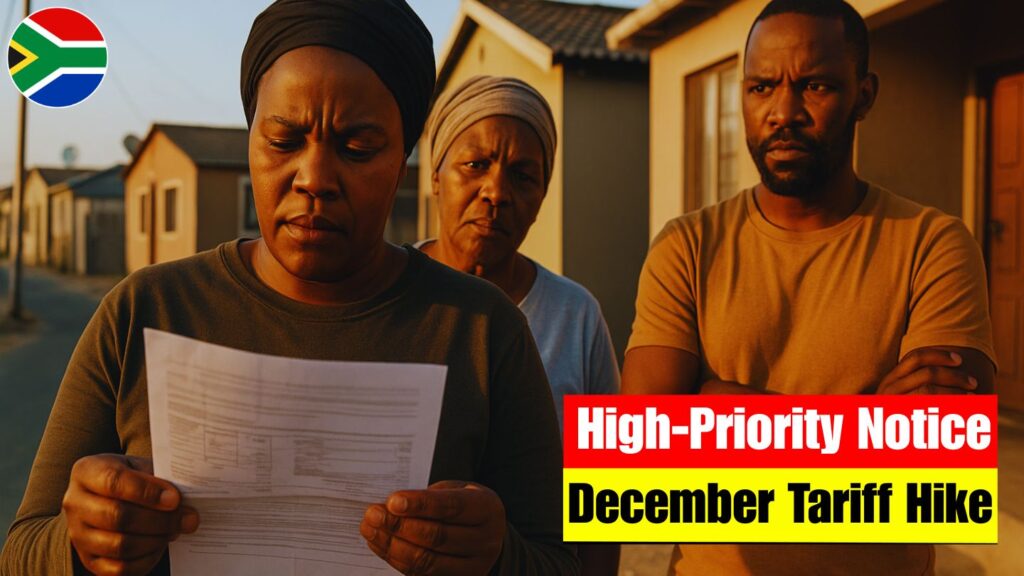South Africans are preparing for the newest electricity tariff increase and many want to know how much their power bills will change this month. The National Energy Regulator of South Africa approved a tariff hike that started on November 25 and it affects households throughout the country. The cost of living is already increasing so this adjustment adds another financial burden on the average consumer. People from Johannesburg to the Western Cape are getting ready to adjust their budgets to handle these changes. Knowing the details of this hike & how it affects your monthly expenses is important for planning your finances properly.

Breaking Down the December 1 Electricity Tariff Hike
The electricity price increase starting on November 25 is part of a wider plan to solve the money problems facing Eskom, which is South Africa’s main electricity provider. Eskom has been dealing with serious financial troubles for several years now and has needed to raise prices to keep supplying power to the whole country. This year the increase is expected to be about 15%, which is a large rise that will impact homes and businesses alike. South Africans are still dealing with regular load shedding so finding lasting answers for power supply & management is becoming more urgent. Consumers will need to watch their energy use carefully to reduce the impact of higher bills.
 November Brings New UK Licence Regulations – Drivers Aged 55 and Above Advised to Review Key Changes
November Brings New UK Licence Regulations – Drivers Aged 55 and Above Advised to Review Key Changes
– Conserve Energy: Simple actions such as turning off lights when not in use can significantly reduce electricity usage.
– Invest in Energy-efficient Appliances: Switching to energy-saving bulbs and appliances can cut down on consumption.
– Consider Alternative Energy Sources: With solar installations becoming more affordable, they present a viable option for reducing reliance on the grid.
– Monitor Usage: Regularly check your electricity meter to stay informed about your consumption patterns.
How Rising Electricity Rates Affect South African Homes
The tariff increase will affect different income groups in South Africa in different ways. Households with lower incomes spend more of their money on utilities and will struggle more with these higher costs. The average monthly electricity bill could go up by several hundred rands based on how much power people use. This means families will need to make difficult choices about their spending and focus on paying for essential utilities instead of other things. Small businesses will also face higher running costs that could force them to raise their prices and reduce their profits. For many people the tariff increase is a stark reminder of the continuing energy problems the country faces.
| Household Category | Avg Monthly Usage (kWh) | Old Cost (R) | Revised Cost (R) | Difference (R) | Rate Increase (%) |
|---|---|---|---|---|---|
| Low-Income Homes | 220 | 420 | 485 | 65 | 15.4% |
| Middle-Income Homes | 550 | 1080 | 1245 | 165 | 15.2% |
| High-Income Homes | 1100 | 2150 | 2470 | 320 | 14.8% |
Practical Ways to Reduce the Impact of Higher Bills
With electricity costs continuing to climb higher people and companies are looking for better ways to control their spending. Using energy-efficient methods helps cut down on power use and lowers monthly bills. Small steps like unplugging electronics when you’re not using them or bigger moves like adding solar panels to your property can really help reduce costs. Smart meters are also useful tools that let you track how much energy you use and spot where you can do better.
– Utilize Smart Home Technology: Smart thermostats and meters can help regulate energy use more efficiently.
– Regular Maintenance: Ensure heating and cooling systems are well-maintained to prevent energy wastage.
– Government Rebates: Look for government incentives or rebates for adopting renewable energy sources.
What’s Next for Electricity Tariffs Across South Africa
The recent tariff increase worries many people, but it is just as important to understand what will happen with electricity prices in South Africa going forward. Eskom’s financial recovery plan indicates that more price increases are likely in the coming years. At the same time, the government is working on different ways to provide cleaner and cheaper energy to everyone. These efforts include putting money into renewable energy projects & making current power systems work better. When consumers keep up with these changes they can make smarter choices about their finances & energy use. The government’s energy strategy focuses on several key areas. There are growing investments in wind and solar power projects across the country. Eskom and other energy providers are upgrading old power plants and improving the networks that deliver electricity to homes and businesses. New policies are being put in place to encourage people and companies to use less energy and waste less power. These combined efforts aim to create a more stable and sustainable energy future for South Africa. While prices may continue rising in the short term, the long-term goal is to build an energy system that costs less to run and causes less environmental damage. Citizens who understand these plans can prepare themselves better for the changes ahead.
Essential Guide to the Latest Electricity Rate Changes
With the November 25 tariff hike now in effect, it is crucial for South Africans to understand its implications. The increase is part of efforts to stabilize Eskom’s finances and ensure a reliable power supply. However, this comes at a cost to consumers, who must now navigate higher electricity bills. Staying proactive by adopting energy-efficient practices and exploring alternative energy sources can alleviate some of the financial burdens. Additionally, keeping abreast of government initiatives and potential rebates can further aid in managing expenses.



